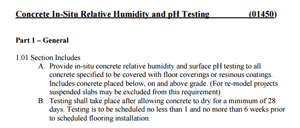Know your standards! How to ensure the integrity of your project design and reduce liability.
The end goal of a properly designed and constructed building is providing the occupants with a warm, dry, efficient, long-lasting environment in which to live or conduct business. As a seasoned architect, you’ll settle for nothing less.
Unfortunately, numerous variables come into play when guiding this dream from idea to reality—many of which involve the integrity of the building envelope. If it is hastily designed or poorly constructed, what should be a dream environment can quickly become a nightmare.
Moisture, whether interior or exterior, can be a catalyst for premature deterioration of building components, health problems due to mold, insect infestations, and more. That’s why good site planning must include utilizing proper moisture measurement standards (F2170 and F1869), and development of the property to ensure proper exterior water drainage so that individual components of the building envelope have the best chance to succeed—therefore making the project a longstanding success.

Proper Moisture Measurement of Floor Slab
As you know, each component of the building envelope must be designed to fit together so it is moisture tight. In this architecture and design section, however, we will focus on the importance of proper floor slab construction and how to ensure the slab will perform as expected. The key is in using the most reliable moisture measurement standard that provides readings you can trust throughout the duration of the project. Since you set the standards for the contractors and installers, any issues down the road could put the liability on you.
In concrete slab design, whether on grade or below, you’ll outline the usual prep work that considers the expectations of the slab, weight and volume of traffic on the floor, stability of the soil, proper rock sub-base layers and compaction, water table levels, and much more. And once all of these variables have been evaluated and the vapor barrier is installed under the slab, the concrete is poured and finished.
Then it’s all good, right?
Not quite yet. The cement, combined with the water, begins the hydration process almost immediately, then the curing and developing of compressive strength. Unfortunately, the amount of water the cement needs to fully hydrate and the amount of water that is conducive for finishing and placing are very different.
For example, a cubic yard of concrete with a water-cement ratio of .5 will have approximately half, or 150 lbs, of water that will not be utilized in the hydration process. This is “free water” or excess water.
This “free water” must be evaporated, to varying degrees, prior to a finished floor product being installed. This equates to many points of water per square foot that must be evaporated from the cement. Any additional moisture added to the slab through wet curing, rain, or high ambient relative humidity conditions further complicate the process. Many coating and flooring manufacturers will not guarantee their products if there is more than 5 percent free water in the concrete.
Effective Drying – The Standards Make the Difference
In order to start the drying process, or more accurately the equilibration process, the concrete must be protected from any additional moisture and contain it in an environment that allows it to evaporate properly. Completing the building envelope, making it air and water tight as quickly as possible and maintaining the conditions in the building close to service conditions, yields the best odds of allowing the slab to meet moisture requirements for finished floor products without the necessity of an additional remediation process.
Specifying the correct type of moisture testing, based on industry standards (www.F2170.org and www.F1869.org), is something that needs to be called out specifically and not assumed. And with the accuracy of the calcium chloride method called into question, consider this a recommendation of specifying that the relative humidity method be used to determine moisture readings during construction.
Note: www.F2170.org and www.F1869.org are the only accepted methods industry-wide. You make the choice that best fits your design project.
